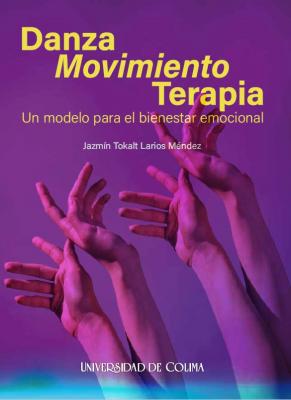Dance Movement Therapy: A Model for Emotional Well-being
Keywords:
Therapy, dance, body, emotionsSynopsis
Dance Movement Therapy (DMT) helps acquire socio-emotional skills, enables self-knowledge, as well as the integration of body and mind; there are many benefits that may be gained from practicing it, this is the reason why it was necessary to write about this topic. In this book, a proposal of DMT methodology which may be applied in groups is established, as well as a model of DMT for emotional well-being, which make a socio-emotional education possible, by way of posing the theoretical bases, the methodology used to reach this model, until it is finally captured and explained, being described as an innovative proposal which has a theoretical foundation and many years in practice.
Downloads
References
ADTA. (2022, 23 de junio). Página principal de la American Dance Therapy Association. https://www.adta.org/
Angera, M. T. (1977). Construcción de modelos en Psicología. Universidad de Barcelona. http://hdl.handle.net/2445/23883
Asociación Argentina de Danzaterapia AADT, (2021, 24 de octubre). Inicio. http://aadt.com.ar/
Asociación de Danza Movimiento Terapia en Chile ADMT, (2021, 24 de octubre).Inicio. https://www.admtchile.cl/
Asociación Española de Danza Movimiento Terapia ADMTE, (2021, 24 de octubre). Inicio. https://danzamovimientoterapia.com/
Álvarez, M., Bisquerra, R., Filella, G., Fita, E., Martínez, F. y Pérez, N. (2001).Diseño y evaluación de programas de educación emocional. Ciss Praxis.
Bayardo, M. G. (2006). Terapia para el cuerpo y el alma. Danza Mexicana Prehispánica. Cuéllar.
Barrantes, L. (2016). Educación emocional. El elemento perdido de la justicia social.Educare, 20(2). https://dialnet.unirioja.es/servlet/articulo?codigo=5460595 https://doi.org/10.15359/ree.20-2.24
Berrol, C. F. (1987). Israel: Dance/Movement Therapy and creative arts therapies in special education. World Rehabilitation Fund, National Institute of Disability and
Rehabilitation Research, United States. Department of Education.
Bernstein, P. L. (1979). Eight theoretical Approaches in Dance-Movement Therapy.Kendall/Hunt Pub. Co.
Blanco, A., Caballero, A., De la Corte, L. (2005). Psicología de los Grupos. Pearson Prentice-Hall.
Berti, G. y Guido, A. (2012). El capital social como recurso humanitario de la frontera Táchira- Norte de Santander. Aldea mundo, 17(33), 15-22.
Bisquerra, R. (Ed.). (2010). La educación emocional en la práctica. Horsori.
Bisquerra, R. (2012). Orientación, tutoría y educación emocional. Síntesis.
Bisquerra, R. (2022). Las competencias para la vida y el bienestar. https://www.rafaelbisquerra.com/competencias-emocionales/las-competencias-para-la-vida-y-el-bienestar/#educacion
Buber, M. (1977). Yo y Tú. Nueva Visión.
Delors, J. (1997). La educación encierra un tesoro. UNESCO.
Fondo de las Naciones Unidas para la Infancia (UNICEF) Venezuela (2017). Habilidades para la vida. Herramientas para el buen trato y la prevención de la violencia. Unicef.org/Venezuela/informes/habilidades-para-la-vida-herramientas-para-el-buentrato-y-la-prevención-de-la-violencia
Fux, M. (1989). La formación del danzaterapeuta. Vivencias con la danzaterapia.Gedisa.
Fux, M. (1998). Danzaterapia. Fragmentos de vida. Lumen.
Goleman, D. (2006). Inteligencia social. La nueva ciencia para mejorar las relaciones humanas. Planeta.
Karkou, V. y Sanderson, P. (2000). Dance Movement Therapy in UK education.Research in Dance Education, 1(1), 69-86. https://doi.org/10.1080/14647890050006596
Kepner, J. I. (1992). Proceso corporal. Un enfoque Gestalt para el trabajo corporal en psicoterapia. Manual Moderno.
López, C. (2016). Naturaleza de los Derechos Humanos. Revista Latinoamericana de los Derechos Humanos, 27(1), 15- 32. https://doi.org/10.15359/rldh.27-1.1
Lowen, A. (1993). La espiritualidad del cuerpo. Paidós.
Navarrete-Cazales, Z. (2015). ¿Otra vez la identidad? Un concepto necesario pero imposible. Revista Mexicana de Investigación Educativa, 20(65), 461- 479.
Perls, F. S. (1975). Yo, hambre y agresión. Los comienzos de la terapia gestaltista. Fondo de Cultura Económica.
Perls, F. S. (1975). Dentro y fuera del tarro de la basura. Cuatro Vientos.
Polster, E. y Polster, M. (1980). Terapia Gestáltica. Amorrortu.
Programa de las Naciones Unidas para el Desarrollo (PNUD). (2019). Informe sobre Desarrollo Humano 2019.
Ramírez, H. y Palladares, P. (2011). Derechos Humanos. Oxford.
Rose, A. (2002). A theoretical model of dance/movement therapy in education: Integrating the body and mind to support holistic learning [Unpublished masters thesis],Columbia College, Chicago.
Ruben, G. S. (1989). EDP Perfil de Desarrollo Emocional. Material para clase de EDP en la Especialidad de Movimiento. INTEGRO.
Ruben, G. S. (2001). Material de lectura para la especialidad de movimiento. INTEGRO.
Ruben, G. S. (2012). Discurso de apertura. En VII Congreso de Danza Movimiento Terapia. Danzando con el amor.
Ruben, G. S. (2014, 21 de noviembre). Video de conversaciones con Gloria Simcha Ruben.
Ruff, M. (2018). Candece Pert y las moléculas de la emoción: documento completo. http://candacepert.com/news/candace-pert-the-molecules-of-emotion-documentary-film-overview/
Salama, H. (2002). Psicoterapia Gestalt. Proceso y metodología. Alfaomega.
Satir, V. (2002). En contacto íntimo. Cómo relacionarse con uno mismo y con los demás. Pax.
Stevens, J. O. (1976). El darse cuenta. Sentir, imaginar, vivenciar. Cuatro vientos.
Watzlawick, P., Weakland, J. H. y Fisch, R. (1982). Cambio. Formación y solución de problemas humanos. Herder.
Yalom, I. y Vinagradov, S. (1996). Guía breve de psicoterapia de grupo. Paidós.

Downloads
Published
Series
Categories
License

This work is licensed under a Creative Commons Attribution-NonCommercial-ShareAlike 4.0 International License.







